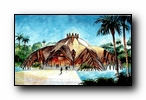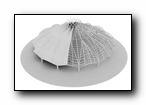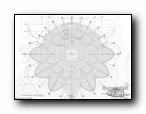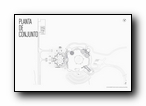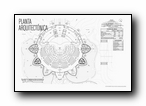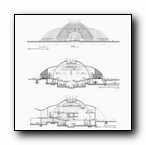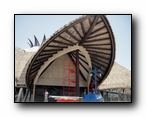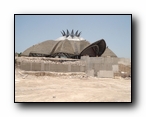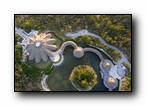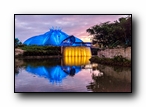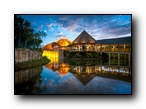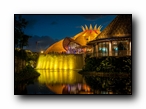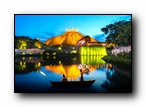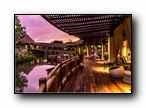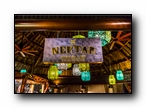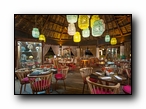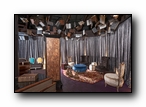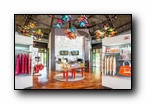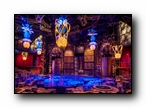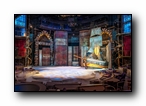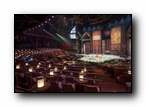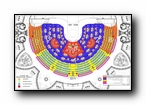
![]()
[ You are here: Grand Chapiteau | Creations | JOYÀ ]
Création
Expérience
RéserveRetiré
Odyssey
From far away, you can just barely see it above the trees, curiously peeking out from the jungle canopy. As you get closer, its strange shape makes you wonder, “What is this?” Maybe it’s a giant flower with its petals unfurled toward the skies. Or a furry animal sleeping soundly on the jungle floor. Is it alive? Who lives there? This strangely beautiful place is the Cirque du Soleil Theater – JOYÀ’s home – at Vidanta Riviera Maya. When Vidanta and Cirque du Soleil set out to build the theater for JOYÀ, their top priority was to create a completely unique and immersive theatrical experience that had never been done before at a resort. Vidanta’s team of master architects, designers, and engineers worked closely with the lead creatives at Cirque du Soleil to bring the dream to life. Grupo Vidanta architect Arturo Hernandez based his designs on three guiding principles: have the utmost respect for the jungle environment, conceal the theater among the mangroves, and play with sinuous lines and organic shapes. The beautiful result of their work is the Cirque du Soleil Theater at Vidanta Riviera Maya – an awe-inspiring structure that transports audiences into the dreamlike world of JOYÀ with timeless beauty, gorgeous natural surroundings, and intricate details. The Theater was purposefully designed to reflect and blend into the lush Mayan jungle, almost like it just sprouted there. With it organic shape and decor, the Theater recaptures the essence of nature – the swaging trees in the breeze, the fluttering of butterflies, animal migrations, and the cycle of life. In fact, if you’ve stepped foot onto any of Vidanta’s resort destinations, you’ve experienced Chief Architect Arturo Hernandez’ brilliant mind at work. Throughout his prolific 33-year career, Arturo has seen the completion of more than 1,500 architectural projects in Mexico. Majestic vistas; soaring palapas; giant tiled columns; brilliant colors; elements of the surreal; playful combinations of water, fire, wood, stone, and metal – these are all the hallmarks of Arturo’s visionary style. Most of Vidanta’s sweeping structures and breathtaking buildings have been designed by this incredible talent. Many of which have helped Vidanta reinvent the Mexican resort experience. Joiningn him in executing these amazing feats of architecture is a full team of more than 125 architects, engineers, designers, and staff. Arturo is an architectural pioneer whose structures often defy physics. His inspiration comes primarily from the natural beauty of Mexico and its wealth of art and cultures, and he cleverly incorporates both into almost every design. Arturo is a true leader and a kind, humble man. Just spend an evening in the Cirque du Soleil Theater... look around and take it all in. You’ll see firsthand why he deserves such praise. When you first saw it, what did you think it was? A plant? An animal? It’s been described as many things – a pomegranate, a furry moth, even an alien. Arturo Hernandez calls it a “beautiful flower.” This is the beauty of the Theater – it invites you to explore your own imagination. It begs you to think about your world, what is a dream and what is reality, and if there really is any difference. Much like the journey of JOYÀ itself. Because of the Theater’s complex geometry (not many right angles here!), one of the main construction challenges was in the installation of the HVAC systems. The kitchen, the stage, the audience areas, the basement, and other areas all require different temperatures at various times during the show! But that's not all. Construction in this ecologically rich part of Mexico is subject to stringent environmental controls and restrictions; it is prohibited, for example, to build anything above the 12-meter tree line of the lush, low-lying jungle that is not made of natural materials. During construction of the JOYÀ site, Vidanta went to extremes to protect the jungle. Trees, rare plans and animals were all displaced. Every plant that was moved, no matter how large, was relocated and replanted. Hundreds of new trees were planted in and around the site. To better preserve the natural habitat, the wooden walkway leading to the theatre was deliberately built above ground, allowing animals to pass freely underneath. 80% of the Theater was preserved as pristine jungle. 100% of permeable ecological concrete was used for roads and parking lots around the site. And local woods were used for pergolas and other decorative elements. Did you know, hidden away on the island in the lagoon, is a small cenote? Abundant in the Yucatán Peninsula of Mexico, cenotes are naturally occurring sinkholes resulting from the collapse of limestone bedrock that expose groundwater underneath. The Maya believed these pools were sacred gateways to the afterlife, their openings representing sacred portals to a mythical underworld, a place of awe. The architecture and esthetics of the JOYÀ site reflect and celebrate the Maya’s reverential respect for nature and are inspired by the natural beauty of the surrounding jungle, which sits atop an intricate underground labyrinth of rivers and cenotes. In fact, the entire JOYÀ site concept is meant to give the impression one is stepping into a large cenote among the mangroves, complete with crystal-clear water pools, coral rocks, and a magnificent waterfall. When architects discovered it during construction, they protected the cenote by creating the island around it. If you peek behind the curtain and look past its stunning artistry, you’ll see that the theater is a marvel of form and function. Despite the theater’s organic shape and softness, it is one of the most technically advanced theaters ever built. (In fact, The Cirque du Soleil Theater has the most highly advanced sound system of any public building in Mexico!)
The performance happens in front of you, behind you, and sometimes right under your nose – characters emerge from every nook and cranny in the theater. It is a show full of incredible energy, endless surprises, and stunning physical and mental feats. JOYÀ combines all of the artistic and technical disciplines – acting, music, sound, lighting, special effects, makeup, costumes, sets, props, and storytelling – to stimulate every sense and fully immerse you in a magical world. Our story begins in the whimsical workshop / laboratory / library of Mr. Zelig, an endearing old alchemist who performs mad experiments to find the meaning of life, helped by his band of half-animal, half-human assistants. Joya, his granddaughter, pays Zelig a visit and accidentally leads them on a wild journey through the magical mangroves. Along the way, they encounter strange characters who do amazing things. Throughout their zany and mysterious journey, Zelig passes generations of knowledge to Joya, teaching her important lessons about nature, the universe, and herself. The story of JOYÀ is a story of love – love for family and friends, love for learning, and love for life. The theatre suggests a Naturalium, a great library and a place of knowledge whose architecture blends with the natural environment. As Mexico is home to one of the largest universities in the world, a country in which the transfer of knowledge dates back to the ancient Mayan civilization, the naturalium is filled with old books collected over time by Zelig, an aging naturalist, and his assistants, the Masters. Certain parts of the set also evoke a vivarium (the plant world) and a terrarium (the mineral world). To illustrate the idea of the transmission of knowledge, set designer Guillaume Lord decided to integrate two gigantic books upstage. High up above, the technical grid is hidden away behind a gigantic mechanism that represents a time machine created on the same scale as the books. As Zelig’s naturalium is a place where knowledge has been collected over time, there is no set time period per se, but rather a collection of time periods: we see a radio from the 1920s, Renaissance patterns on the floor, clocks from the Victorian era, a preindustrial staircase, a large contemporary mural, etc. Throughout the show, the space undergoes a series of transformations based on the narrative. Large scrims are used to separate the stage from the audience in order to suggest an underwater world. Hordes of pirates emerge from a large book and take the stage – and the audience – by storm. The naturalium is turned into a jungle when a giant vine descends onto the stage around an 8.5-meter-tall flower. A huge mural in the style of Mexican fresco painter Diego Rivera appears on stage to represent the inner world of Zelig’s granddaughter, Joyà. The Cirque du Soleil Theater is more than a physical place – it has become another lovable character in a show that amazes audiences each night. Did you know it took 18 months to build? With 600 seats, it is the most intimate Cirque du Soleil theater. Even the seats farthest from the stage are only 18 meters away! Guests enjoy 2 distinct dining areas, 2 bars, and 2 lounges. 832 tons of steel were used to make the structure. 218,362 meters of electrical cable run through the theater. And 17,000 square-meters of ecological concrete were used for roads and parking lots, all 100% permeable. But there's more to JOYÀ than just the theater and grounds. There's also the food! Did you know the kitchen crew - the chefs, sous chefs, servers, and bussers - have to rehearse their parts just like the actors? Leading up to the show, the dinner service was rehearsed for weeks to get the timing just right. Learn a bit more about the creation and highlights of the show's fantastic menu in: the Gastronomy section. |



